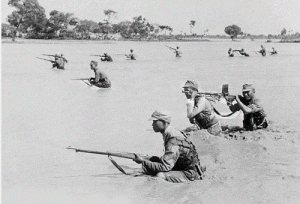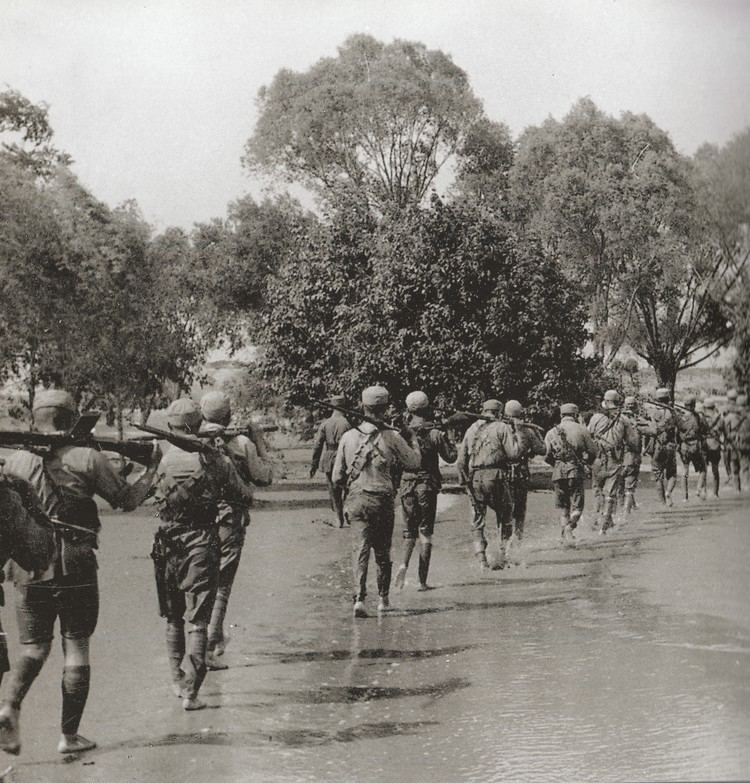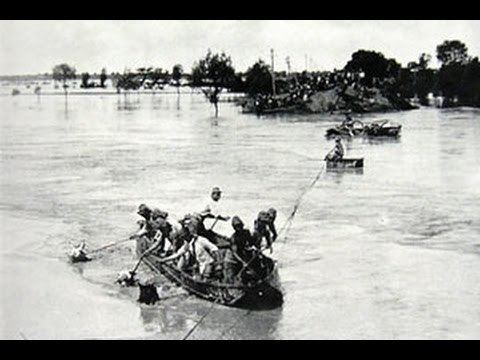Start date June 9, 1938 | End date 1938 | |
Similar 1938 Changsha fire, 1931 China floods, Banqiao Dam, 1998 China floods, 1887 Yellow River flood | ||
The 1938 yellow river flood
The 1938 Yellow River flood (Chinese: 花园口决堤事件; pinyin: huāyuán kǒu juédī shìjiàn, literally "Huayuankou embankment breach event") was a flood created by the Nationalist Government in central China during the early stage of the Second Sino-Japanese War in an attempt to halt the rapid advance of Japanese forces. It has been called the "largest act of environmental warfare in history."
Contents
- The 1938 yellow river flood
- The strategic decision and the flood
- Controversy over the strategy
- Controversy over the number of casualties
- Aftermath
- References

The strategic decision and the flood

Following the onset of the Second Sino-Japanese War in 1937, the Imperial Japanese Army marched rapidly into the heart of Chinese territory. By June 1938, the Japanese had control of all of North China. On June 6, they captured Kaifeng, the capital of Henan, and threatened to take over Zhengzhou, the junction of the arterial Pinghan and Longhai Railways. Japanese success here would have directly endangered the major cities of Wuhan and Xi'an.

To stop further Japanese advances into western and southern China, Chiang Kai-shek, at the suggestion of Chen Guofu, determined to open up the dikes on the Yellow River near Zhengzhou. The original plan was to destroy the dike at Zhaokou, but due to difficulties at that location, the dike at Huayuankou, on the south bank, was destroyed on June 5 and June 7, with waters flooding into Henan, Anhui, and Jiangsu. The floods covered and destroyed thousands of square kilometers of farmland and shifted the mouth of the Yellow River hundreds of miles to the south. Thousands of villages were inundated or destroyed and several million villagers driven from their homes and made refugees. An official Kuomintang post-war commission estimated that 800,000 drowned, which may be an underestimate.
Controversy over the strategy

The strategic value of the flood has been questioned. Japanese troops were out of its range, either to the north and east or to the south. Their advance on Zhengzhou was halted, but they took Wuhan in October by attacking from a different direction. The Japanese did not occupy much of Henan until late in the war and their hold on Anhui and Jiangsu remained tenuous. Most of the towns and transport lines in the areas which were flooded had already been captured by the Japanese; after the flood they could not consolidate their control over the area, and large parts of it became guerrilla areas.
Controversy over the number of casualties

The number of casualties in the flood remains disputed and estimates have been revised by the Chinese government and other researchers in the decades after the event. There is no way of accurately assessing the casualties: much of the population, including officials, had already fled, leaving no government control and no one to count the dead. In the shifting battles between bandits, Nationalists, Communists, and Japanese, counting casualties was not a high priority. The Nationalist government, after initially claiming that the breach was caused by Japanese bombing, used the heavy casualties to demonstrate the scale of sacrifice required of the Chinese people; it claimed that 12 million people had been affected by the flood, and in 1948 it estimated the number of deaths at 800,000. A 1994 PRC (People's Republic of China) official history of the war put the dead in the flood at 900,000 and the refugees at nearly 10 million. Scholars exploring the archives now give much lower figures: 400,000–500,000 dead, 3 million refugees, and 5 million people affected (another estimate puts the number of dead at 500,000, and the number of homeless at 500,000).
Aftermath

Besides the massive death toll, the flooded areas were affected for years to come. The flooded countryside was more or less abandoned and all the crops destroyed. Upon the recession of the waters much of the ground was uncultivable as much of the soil was covered in silt. Many of the public structures and housing were also destroyed, leaving any survivors destitute. The irrigation channels were also ruined, further adding to the ecological toll on the farmlands. The destruction also had an adverse effect on the Chinese population. Unable to fully decide which group deserved more blame for the catastrophe, the Chinese Government or the invading Japanese, many survivors blamed both sides. The flooded area became a fertile recruiting ground for the Chinese Communists, who used survivors' anger towards a shared enemy to bring them into their ranks. By the 1940s the area had evolved into a major guerrilla base known as the Yuwansu Base Area.
The breach in the dam became such a major rallying point for the Communists that they actually tried to halt an attempt by the Chinese Government, with the assistance of the UN, to seal the breach. Their armed resistance ultimately failed and the dikes were rebuilt in 1946 and 1947 and the Yellow River returned to its pre-1938 course. The point was nevertheless made; the breach had in the end given the Communists a huge boost in the North.
